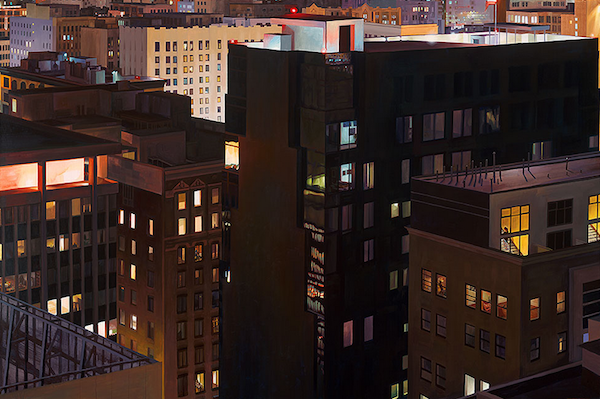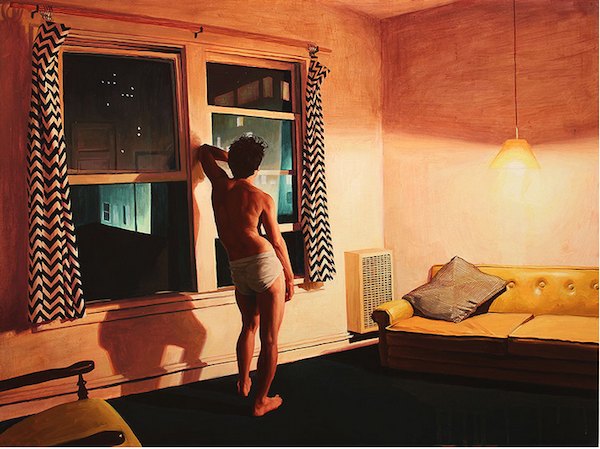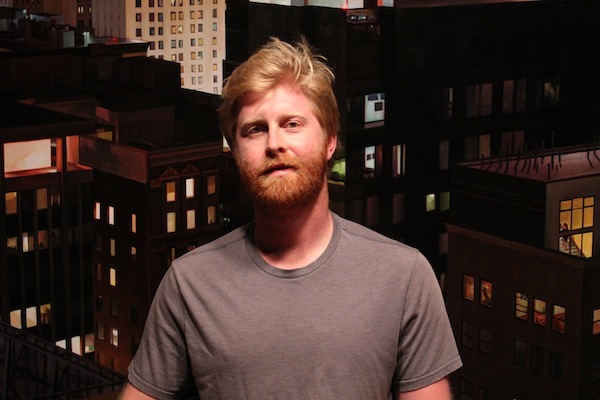California Casual (At Robert Spencer’s), 2013
Deep in the recesses of downtown Los Angeles’ Fashion District, a painter by the name of Seth Armstrong is busy concocting a story about the surrounding city inhabitants. His current show “Lovin’ Thy Neighbor” at Thinkspace Gallery in Culver City highlights a concept central to his body of work: the artist-as-voyeur. Simultaneously epic and intimate, this show successfully combines iconic LA environments with focused portraits detailing the storylines happening inside: each “still” captures a scene on pause. Armstrong’s eye for eccentric detail and mastery of the medium evoke a cinematic perspective often compared to film noir. I sat down with Seth recently in his studio to discuss superheroes, secret details, and his unique approach to visual storytelling.
Katharine Hargreaves: How would you describe yourself as an artist?
Seth Armstrong: I am a painter first and foremost. I like painting all kinds of things. Most of it is figurative or based in reality but there is always a weird element present. Whether it’s based in the narrative or an actual element of the composition, you might not be able to see whatever special nugget I’ve put in there for myself unless you see it in person.
KH: Is that similar to an Easter egg on a website that reveals a secret response if you click on it?
SA: Yes…especially with this painting I’m working on right now. The idea being that the only way to really see what the painting encapsulates is to view it in person. There’s no way you could look at a jpeg online and see all the detail involved. There’s dozens of little scenes happening in the windows of these buildings.
KH: Let’s talk about your upcoming show. You have a large cityscape at the center and several smaller paintings that elaborate on the narratives happening throughout the painting.
SA: A lot of the paintings that I’ve done in the past are scenic cityscapes. There’s usually a scene happening somewhere in the windows but a lot of people miss these. I have to give credit to Andrew, the guy who runs Thinkspace Gallery (where the show is held) for coming up with the idea of connecting the two. All of the paintings in the show stand alone and to some extent, appear unrelated in nature. But in reality all these scenes are taking place in the same moment. This is made clear in the mother painting.

KH: Can you describe the mother painting?
SA: That’s what I’ve been calling the big painting of the cityscape: the mother painting. The smaller paintings are like satellites. They focus on the scenes taking place in the windows of the buildings in the mother painting.
KH: I think satellite is a good definition. An epic view can become mundane after too many attempts. But the addition of these satellite paintings and their unique story lines seem emblematic of city life in and of itself.
SA: In most of the smaller paintings, I don’t know what’s happening outside the scene. Whatever motivations these characters have is unknown to me. I don’t want to define that relationship. I have ideas about what’s happening – specifically in the scenes I compose – and ask the models at times to emulate certain feelings but I’m not trying to advertise that specific idea or emotion. I like to leave it open for an element of mystery.
KH: You have some very evocative people in your paintings. How do you choose your subjects?
SA: I’ll see a window that’s empty and want something to be happening. Sometimes I’ll come across a found photograph that I think would make a good painting on its own. The cool thing about this show is that it’s an easy way to tie together ideas that normally have nothing to do with each other. When you look at my body of work, my paintings are very different. I’ve never had a show where every painting was united by a cohesive idea.

KH: Do you think people respond more to the intimate portraits (of people) or to the epic scenes (environments)?
SA: People respond more to the intimacy and emotions of the smaller paintings. The ones who respond the most are those who get close and notice the details. When they discover the story lines contained, it makes the painting more powerful. It’s funny watching people notice the naked lady in the window they didn’t know about. They’re happy and entertained.
KH: Themes in your artwork include windows and western archetypes. What draws you to these things?
SA: I always liked scenes within scenes or places within places. I grew up in Los Angeles and my parents’ house is on top of a little hill. The view out of the dining room is of all these houses in the distance. For most of my life I looked at these houses and wondered if everyone else was eating dinner also. If I’m looking out at the world, I want to see something happening. I can appreciate the beauty of a view, but I want to know why the lights are out. Or if it’s four in the morning, what is that person doing? A lot of [what I paint] are things I wish would happen; usually a lady getting undressed or people having sex.
KH: The voyeuristic urge is a common one.
SA: I’m lucky I’m an artist because I can actually fulfill that urge without getting shit for it – at least that’s the hope.
KH: What about the recurring Western themes?
SA: Years ago my friend Sam described my paintings as having a “masculine absurdity.” I really like those two words together. I want to be a strong guy who can exude a certain presence but I also see that attitude as being utterly ridiculous. I feel like that trait, especially here in Los Angeles, becomes super prevalent. I think a lot of it has to do with my dad. He’s a guy’s guy, super cool, but also ridiculous at times. I mean, whose dad isn’t? He’s an actor and I grew up watching him in plays all the time — Shakespeare; always stabbing people.
KH: There’s a freedom in your work that isn’t limited to simple stereotypes about masculinity.
SA: I haven’t heard my work as being described as free before. People like to talk about the technical stuff that goes into it: the brushstrokes and layers as opposed to the subject matter. So it’s cool that you see that.
KH: Your work is clearly technically proficient. However, what’s more interesting to me is the position of the voyeur. Who doesn’t wish for that freedom at some point? We can appreciate that impulse from a safe distance because your paintings allow us to inhabit that role without getting caught.
SA: When I think about it, I’ve being painting the same things since I was a kid: superheros and girls. In the end, those two things aren’t all that different. I’m beating around the bush more now. I don’t want to make it obvious. I don’t enjoy obvious art. If there’s a picture of a woman, I want to know why she’s sitting there or standing there. I wonder why she just got dressed or remains undressed. I don’t want to subjugate anyone; I want to interrogate them.

KH: Your paintings invite a lot of questions from the viewer. There’s no answers as to
why certain situations are happening (such as the superhero robbing the couple) but I think people will try and attempt to understand what justifies their inclusion.
SA: Hopefully. I also want people to look at the physical paint too. It’s not all about the subject matter – I like having fun with the material too.

KH: What in particular do you enjoy about the medium?
SA: I’m constantly doubting what I’ve just done and how I’ve done it. Even though a lot of times it looks like I’ve gotten to the same place I’ve taken completely different routes to get there insofar as the actual application of paint. Each painting looks different from the others because I can’t do the same thing over and over again. Looking at my body of work as a whole, you know it’s “Seth” but if you were to put one painting next to another they would still look completely different – to me, at least. There are a lot of layers that you don’t notice until you stand in front of that painting. It just doesn’t translate from the photographs – which is the whole idea of painting I think. It’s a physical thing.
Make sure to catch Seth’s show at Thinkspace Gallery in Culver City, through October 26, 2013.
Katharine Hargreaves is the Creative Director of Whole Beast Rag. Her projects are concerned with the critical examination of cultural infrastructures, systems, symbols, and the everyday spectacle. She lives and plays in Los Angeles. Find more of her work at www.projektkatharine.net.
